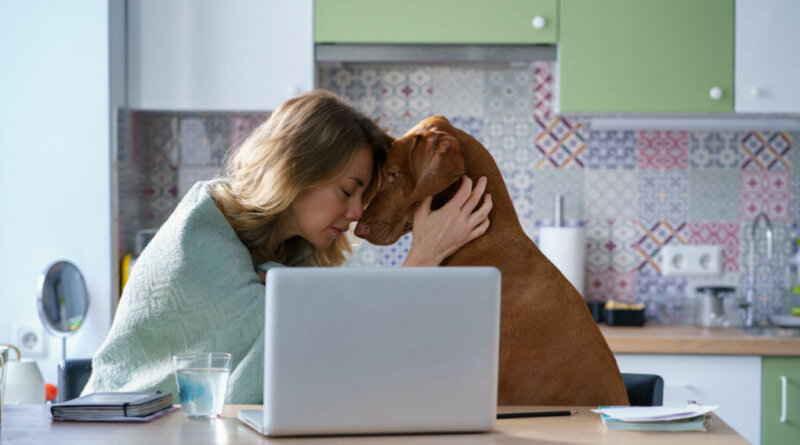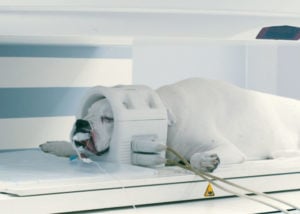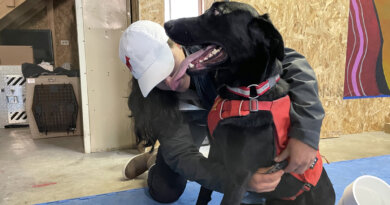Dog Dementia Checklist – Top Dog Tips
HAVE YOU BEEN NOTICING your dog’s strange behavior the past couple of days?
Maybe you noticed his non-stop pacing, general confusion, and/or nightly barking session?
If you’re reading this article, you’re probably suspecting Dog Dementia.
But before hauling your dog to the vet clinic, it’s important to know and get all the facts straight first.
Below, we have compiled a comprehensive questionnaire that will serve as your Dog Dementia Checklist.
You can print it or save it on your phone. Just make sure to bring it over to your veterinarian as he’d surely want to hear (or see!) all your observations to help fast-track your dog’s diagnosis.
Let’s discuss what is Canine Cognitive Dysfunction or Dog Dementia, how to test for it, and the checklist you’ll be needing to answer for this purpose.
What is Dog Dementia?
Canine Cognitive Dysfunction, or Cognitive Dysfunction Syndrome in dogs, or Dog Dementia, is a condition where the brain undergoes changes usually brought about by old age.
It’s often compared to human Alzheimer’s disease but in dogs.
Now we don’t want to sound too complicated here but basically, protein plaques (beta-amyloid protein) get stuck in the brain causing inflammation and eventually killing cells off.
This sends the wrong signals from the brain to the body—causing permanent changes affecting their physical and mental capabilities.
And did you know 14% to 35% of old dogs do get dementia? On top of that, there’s a recent study saying that a dog’s risk of dementia increases by half every year.
That info may not help in the practical sense but just think that you’re not alone in this fight. A lot of dog owners and pets have gone through or are going through what you’re experiencing right now.
How to Test for Dog Dementia?
Actually, there is not one test that can specifically diagnose dementia in dogs.
In reality, it will be more of a diagnosis by deduction—the veterinarian will conduct a series of tests to rule out other possible diseases that may be causing your dog’s symptoms.
A complete physical examination will be done, along with routine blood tests, urine tests, thyroid testing, ultrasound, and X-rays, among others.
These tests should possibly help rule out:
- Liver Diseases
- Kidney Diseases
- Diabetes
- Hypothyroidism
- Cushing’s Disease
- Any other diseases that may be causing pain
If your dog has been cleared for any or more of these diseases, advanced imaging tests like MRI or CT Scans will eventually be conducted.
At this point, the checklist (which we’ll get to in a while) will be very helpful in eventually diagnosing if your dog’s condition is indeed Canine Dementia.
DISHAA
Dog owners need to be able to identify specific patterns in their dog’s behavior to effectively help their veterinarian assess the mental acuity of a dog. With this, the DISHAA Tool was formulated.
DISHAA stands for:
- Disorientation
- Interaction
- Sleep/Wake Cycle
- House soiling, Learning, and Memory
- Activity
- Anxiety
All of the symptoms a dog with dementia exhibits each fall under one or more of these categories.
Dog Dementia Checklist
Following the DISHAA Tool, here’s the checklist you can print or save on your phone for easier access.
DOG DEMENTIA CHECKLIST
|
DISORIENTATION |
YES |
NO |
| My dog gets stuck often | ||
| My dog has difficulty getting around objects in the house | ||
| My dog waits at the hinge part of the door; seems confused about how it works | ||
| My dog zones out; he stares blankly at walls, the floor, or into space | ||
| My dog often walks into doors, walls, and other tight spaces and gets stuck there | ||
| My dog gets lost in our home or in the backyard | ||
| My dog startles easily | ||
| My dog keeps falling off things | ||
| My dog has trouble with eating or drinking; can’t seem to find his bowl, etc.) | ||
| My dog sometimes drops food and has trouble finding it | ||
| My dog doesn’t react much to what he sees or hears | ||
|
SOCIAL INTERACTIONS |
YES |
NO |
| My dog does not recognize familiar people or pets anymore | ||
| My dog does not seem to enjoy petting or interacting with the family | ||
| My dog is very clingy and overly-attached | ||
| My dog gets more irritable/fearful/aggressive with visitors, family members, or other pets | ||
| My dog is not as playful as he was before | ||
|
SLEEP/WAKE CYCLES |
YES |
NO |
| My dog is restless at night; he keeps on pacing and can’t seem to sleep | ||
| My dog sleeps a lot more during the day than before | ||
| My dog often barks or howls during the night | ||
|
HOUSE SOILING, LEARNING, AND MEMORY |
YES |
NO |
| My dog has been defecating inside the house (despite previous housetraining) | ||
| My dog has been urinating inside the house (despite previous housetraining) | ||
| My dog can’t seem to signal anymore when he needs to go outside for potty | ||
| My dog seems to forget his routines; he sometimes starts but only gets halfway through | ||
| My dog is not responding to previously learned commands and names | ||
| My dog seems less able to learn new tasks | ||
| My dog seems to have decreased focus these days | ||
|
ACTIVITY |
YES |
NO |
| My dog is more vocal (barking, howling) than usual for no apparent reason | ||
| MY dog doesn’t bark as much when he’s usually vocal | ||
| My dog seems to be having motor difficulties like walking backward | ||
| My dog is not interested anymore in our daily walks/exercise | ||
| My dog doesn’t play that much with his favorite toys, family members, and other pets | ||
| My dog does more aimless pacing and wandering these days | ||
| My dog does a lot of repetitive behaviors like circling, chewing, licking, stargazing, etc.) | ||
|
ANXIETY |
YES |
NO |
| My dog looks more fearful and unsettled than usual | ||
| My dog gets more anxious being separated even for just a while | ||
| My dog seems more afraid of new things and places than before | ||
| My dog is trembling for seemingly no reason |
How Can I Help my Dog with Dementia?
Getting the checklist above done is the first step in helping your dog with dementia.
This will make it easier not only for your pet but for both you and the veterinarian to diagnose it and get something done to it.
Unfortunately, there is no cure for dog dementia just like Alzheimer’s in humans.
You and your vet can only try to slow down the progress of this disease and improve your pet’s quality of life.
Take notes
The first thing you can do is take notes. List down all the “accidents or incidents” that are happening to your dog—the soiling, the late-night pacing, or getting stuck in furniture.
Identify which ones keep on happening and how frequent they are in a day or in a week.
This will help you not only report to the vet during your dog’s follow-up check-up but also help manage your pet’s changed behavior.
Keep a routine
Dogs like routine, and at this moment in their lives, they’d appreciate it more if you keep them in a routine.
They’d probably forget to do it at times (even though you’re doing it every day!) but just be patient.
This will help reduce their confusion and anxiety and may help them better sleep at night.
If you noticed through your notes that your dog is getting more and more restless in the evening, try to keep them busy during the day so they’d get tired and sleep straight at night.
Or if they keep soiling themselves at a specific time of the day, try to walk them outside to go potty before it happens.
Brain games!
Keep your everyday routine fun by incorporating brain games, too.
It’s important to keep their minds active and sharp to slow down the progress of dementia.
You can do this by having them use puzzle feeders, playing hide and seek, or teaching them new tricks.
If they’re having trouble keeping up in learning new tricks, try re-inforcing old tricks instead.
Anything that will make their brains stimulated will help manage the signs and symptoms of dog dementia.
Pet-proof the house
Environment management is also an important element in helping your dog cope with dog dementia.
Pet-proofing the house and keeping their surroundings open and simple will help them navigate their way through it.
Always keep their water and food bowls near their sight. You can also prepare diapers, pads, and waterproof beds to deal with soiling accidents.
Consider medications or supplements
Seek your veterinarian’s approval on what medications your dog with dementia needs.
There are pills they can take to regulate their sleep-wake cycle, or manage their anxiety and help calm them down.
Feeding your dog nutritious foods and adding in some supplements for brain health will also help in keeping their physical and mental state healthy.
Just remember not to self-medicate—always ask for your vet’s recommendation.
Listen to your dog’s needs
As dog dementia progresses, your pet’s needs will also progress.
You’ll probably notice some indicators increase over time, get more frequent, or get too difficult to manage.
Because of this, you may have to add a couple more activities or precautions in your daily routine to help your dog get through each day.
Patience is key in learning to adapt and adjust your care to their needs.
FAQs on Dog Dementia
What are the first signs of dog dementia?
Dementia starts in the Mild stage, and it’s normal for some fur parents to not notice signs and symptoms during this because, well, it’s still in its mild form.
Dog dementia usually starts with general disorientation. They seem to keep forgetting what they’re about to do or where they’re supposed to go.
Slight changes in their sleeping pattern may also begin at this point, as well as decreased interaction with family members.
How long can a dog live with dementia?
Dog dementia not only affects a dog’s mental well-being but his overall quality of life, too.
Although there are some experts say dogs can live with dementia for up to 2 years, it’s still going to be on a case-to-case basis.
It will depend on the overall health and welfare of the dog and how fast its cognitive abilities will deteriorate.
It’s also important to keep working with your dog’s veterinarian for symptom management.
When should you euthanize a dog with dementia?
Choosing to let our dogs go will be one of the most difficult decisions any fur parent will do in his life but sometimes, considering euthanasia is kinder and more merciful than keeping them.
As dog owners, we should understand how important it is for our dogs to live a quality life—one where they can be happy and free with their loved ones.
With our help, our dogs will and can exist with dementia. But if it’s not the life where they are happy, will that be worth it?
You know your dog better than anyone else. Eventually, you’ll know if and when it’s time to let them cross the rainbow bridge.
What medication is used for older dog dementia?
There are medications that were purposely formulated to deal with dementia in dogs.
One of the meds that are widely prescribed for Canine Cognitive Dysfunction is the drug Selegiline Hydrochloride.
It’s been proven to slow down the progression of dementia and improve the brain function of a dog diagnosed with CCD.
But again, don’t self-medicate your dog. Consult with your veterinarian to know if giving medicines is appropriate for your dog’s condition.
How do you treat dementia in dogs naturally?
There is no proven cure for dementia. But there are some natural remedies that some owners do that wouldn’t hurt to try.
There are herbal treatments that are said can improve overall cognition, such as the herb rosemary.
Giving dogs rosemary-based dishes may help with their memory and brain functioning, and give them a boost of energy.
Just make sure not to overdo it though! As we know, too much of things are bad for one’s health. Also, don’t forget to consult with your vet regarding this too!
Dog Dementia Checklist: Summary
Now that you have the dog dementia checklist on hand, know that both your and your dog’s new journey is only beginning.
In this article, we have touched on several important things that you have to remember if your pet is suspected to suffer from dog dementia.
One of them is DISHAA (Disorientation, Interaction, Sleep/Wake Cycle, House soiling, Learning, and Memory, Activity, and Anxiety).
Familiarizing yourself with this will help you recognize faster all signs and symptoms your dog’s condition may be manifesting.
Print the checklist, bookmark this article, or save this post for easy access when you need it.
READ NEXT: Dog Dementia Stages: What You Need To Know
Related









viagra naturale in farmacia senza ricetta: kamagra senza ricetta in farmacia viagra generico recensioni
oniondir deep web link directory darknet sites url [url=https://worlddrugsmarket.com/ ]darknet market ranking [/url]
Namoz vaqtlari https://www.elephantjournal.com/profile/nodirgroup/